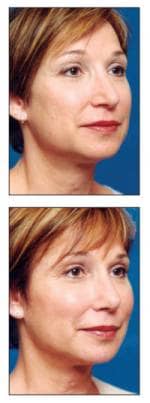Stem cells have received significant attention as an ideal source of regenerative-capable cells because of their multipotentiality and ability to replicate. Furthermore, stem cells have been used in a limited fashion for decades with great clinical success.
This article reviews some of the recent literature about stem cells and their use as a promising filler, and will discuss potentials and limitations.
The literature regarding stem cells were reviewed and summarized to include reported indications for use of stem cells as a filler, either a single agent or in combination with hyaluronic acid gel or acellular dermal matrix. We will briefly use the fat graft model and discuss its limitations compared with stem cells.
EMBRYONIC STEM CELLS
Embryonic stem cells are derived from the inner cell mass of the blastocyst and have the capacity to differentiate into all tissues of the body.1
Both mouse and human embryonic stem cells have demonstrated an in vitro capacity to form cardiomyocytes, hematopoietic progenitors, neurons, skeletal myocytes, adipocytes, osteocytes, chondrocytes, endothelial cells, and pancreatic islet cells when cultured under specific growth factor conditions.2,3
Multiple limitations, however, currently exist regarding the use of human embryonic stem cells in regenerative medicine. This includes unregulated differentiation and formation of teratomas and teratocarcinomas, especially in undifferentiated states and the potential immune response to an embryonic stem cell-derived tissue graft. Concerns have been raised over the acquisition of immunogenic residues secondary to culture on mouse feeder cells.4
Somatic nuclear cell transfer, also referred to as therapeutic cloning, involves the transfer of nuclei from postnatal somatic cells into an enucleated ovum. Mitotic divisions of this cell in culture lead to the generation of a blastocyst capable of yielding a whole new organism.5

A 51-year-old female patient before (top) and after 6 months of fat grafting to the face (bottom).
ADULT STEM CELLS
In contrast with embryonic-derived tissues, adult stem cell sources avoid the ethical concerns regarding fetal tissue harvesting for tissue-engineering purposes.
For tissue-engineering purposes, a well-studied adult stem cell population includes mesenchymal stem cells. Mesenchymal stem cells have been isolated from bone marrow, umbilical cord blood, and adipose tissue. The tissue origin of mesenchymal stem cells seems to be a major determinant of progenitor characteristics.
Adipose tissue-derived stem cells, in particular, fulfill several requirements proposed for successful clinical use in regenerative applications6: They can be readily harvested during a minor liposuction procedure under local anesthesia, and they have been successfully used in regenerative applications in numerous animal models. During this procedure, they demonstrated the capacity to differentiate into cartilage, bone, muscle, and adipose tissue.
TISSUE-SPECIFIC STEM CELLS
In addition to embryonic stem cells and mesenchymal stem cells, tissue-specific "resident" stem cells have been identified in almost all postnatal tissues and organs.7 They are capable of both self-renewal and differentiation throughout an individual’s life span and utilize both mechanisms to maintain a steady state and regenerate injured tissue.8
More.
[Source: PSP]




